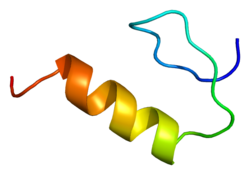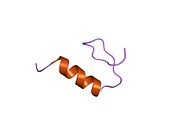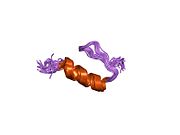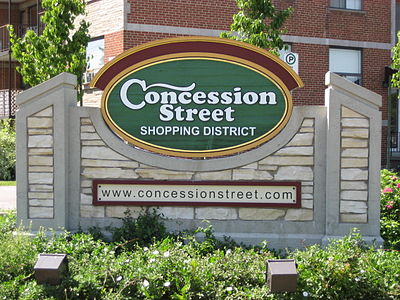Sp1 전사율
Sp1 transcription factor특이성 단백질 1*로도 알려진 전사인자 Sp1은 SP1 [5]유전자에 의해 인간에서 암호화되는 단백질이다.
기능.
이 유전자에 의해 코드된 단백질은 많은 프로모터의 GC가 풍부한 모티브에 결합하는 아연 손가락 전사 인자입니다.암호화된 단백질은 세포 분화, 세포 성장, 아포토시스, 면역 반응, DNA 손상에 대한 반응, 그리고 염색질 리모델링을 포함한 많은 세포 과정에 관여합니다.인산화, 아세틸화, O-GlcNAcylation 및 단백질 분해 처리와 같은 번역 후 변형은 활성제 또는 억제제가 [5]될 수 있는 이 단백질의 활성에 유의하게 영향을 미친다.
SV40 바이러스에서 Sp1은 게놈의 조절영역(RR)에서 GC박스에 결합한다.
구조.
SP1은 Sp/KLF 계열의 전사 인자에 속합니다.단백질은 785개의 아미노산 길이에 분자량은 81kDa이다.SP1 전사 인자는 N 말단에 프로모터 트랜스 [6]활성화에 필요한 것으로 여겨지는 2개의 글루타민이 풍부한 활성화 도메인을 포함한다.SP1은 C 말단에 세 가지 아연 핑거 단백질 모티브를 포함하고 있으며, 이를 통해 DNA에 직접 결합하고 다른 전사 조절제와의 상호작용을 가능하게 한다.그 아연핑거는 Cys2/His형이며2 컨센서스 배열 5'-(G/T)GGGG(G/A)(C/T)-3'(GC박스 요소)와 결합한다.인간 [7]게놈에는 약 1만2000개의 SP-1 결합 부위가 있다.
적용들
Sp1은 아릴 탄화수소 수용체 및/또는 에스트로겐 수용체의 증감을 연구할 때 비교되는 제어단백질로서 사용되어 왔으며, 이는 양쪽 모두에 결합하고 일반적으로 비교적 일정한 [8]수준을 유지하기 때문이다.
최근 FTMT의 추정촉진제 영역 및 양성조절제 {SP1, cAMP 반응요소결합단백질(CREB), 잉양1(YY1)] 및 음성조절제[GATA2, 포크헤드박스단백질 A1(FoxA1), CCAAT 인핸서결합단백질 B/EB]이러한 조절제의 FTMT 프로모터에 대한 DNA 결합 활성에 대한 DFP의 영향은 ChIP(Chromatin Immunopreciation) 분석을 사용하여 조사되었다.조절제 중 SP1만이 용량 의존적 방식으로 DFP 처리 후 유의미한 DNA 결합 활성을 보였다.siRNA에 의한 SP1 녹다운은 FTMT의 mRNA 수준의 DFP 유도 증가를 폐지하여 DFP의 존재 하에서 SP1 매개 FTMT 발현 조절을 나타냈다.Deferiprone에 의한 치료는 세포질 및 핵 SP1의 발현을 증가시켰으며,[9] 핵에서의 국소화가 지배적이었다.
억제제
Streptomyces Plicatus에 의해 생성되는 항종양 항생물질인 Plicamycin과 Withania somnifera 식물의 스테로이드 락톤인 [10][11]Withaferin A는 Sp1 전사인자를 억제하는 것으로 알려져 있다.
miR-375-5p 마이크로RNA는 대장암세포에서 SP1과 YAP1의 발현을 유의미하게 감소시켰다.SP1 및 YAP1 mRNA는 miR-375-5p의 [12]직접 타깃입니다.
상호 작용
Sp1 전사인자는 다음 인자와 상호작용하는 것으로 나타났습니다.
- AATF,[13]
- CEBPB,[14][15]
- COL1A1,[16]
- E2F1,[17][18][19]
- FOSL1,[20]
- 갑파,[21]
- HDAC1,[13][22][23][24]
- HDAC2,[23][24][25]
- HMGA1,[15]
- HCFC1,[26][27]
- HTT,[28]
- KLF6,[29]
- MEF2C,[30]
- MEF2D,[31]
- MSX1,[32]
- 미오제닌[33]
- POU2F1,[26][34]
- PPP1R13L,[35]
- PSMC5,[36][37]
- PML,[38]
- RELA,[39][40]
- SMAD3,[41][42]
- 스모1,[36]
- SF1,[43]
- TAL1,[44]
- UBC.[36]
- WRN,[45]
- DDX3X
레퍼런스
- ^ a b c GRCh38: 앙상블 릴리즈 89: ENSG00000185591 - 앙상블, 2017년 5월
- ^ a b c GRCm38: 앙상블 릴리즈 89: ENSMUSG00000001280 - 앙상블, 2017년 5월
- ^ "Human PubMed Reference:". National Center for Biotechnology Information, U.S. National Library of Medicine.
- ^ "Mouse PubMed Reference:". National Center for Biotechnology Information, U.S. National Library of Medicine.
- ^ a b "Entrez Gene: Sp1 transcription factor".
- ^ Li, Lin; He, Shihua; Sun, Jian-Min; Davie, James R (2004-08-01). "Gene regulation by Sp1 and Sp3". Biochemistry and Cell Biology. 82 (4): 460–471. doi:10.1139/o04-045. ISSN 0829-8211. PMID 15284899.
- ^ Zhang B, Song L, Cai J, Li L, Xu H, Li M, et al. (May 2019). "The LIM protein Ajuba/SP1 complex forms a feed forward loop to induce SP1 target genes and promote pancreatic cancer cell proliferation". Journal of Experimental & Clinical Cancer Research. 38 (1): 205. doi:10.1186/s13046-019-1203-2. PMC 6525466. PMID 31101117.
- ^ Wormke M, Stoner M, Saville B, Walker K, Abdelrahim M, Burghardt R, Safe S (March 2003). "The aryl hydrocarbon receptor mediates degradation of estrogen receptor alpha through activation of proteasomes". Molecular and Cellular Biology. 23 (6): 1843–55. doi:10.1128/MCB.23.6.1843-1855.2003. PMC 149455. PMID 12612060.
- ^ Hara Y, Yanatori I, Tanaka A, Kishi F, Lemasters JJ, Nishina S, et al. (November 2020). "Iron loss triggers mitophagy through induction of mitochondrial ferritin". EMBO Reports. 21 (11): e50202. doi:10.15252/embr.202050202. PMC 7645172. PMID 32975364.
- ^ Choi ES, Nam JS, Jung JY, Cho NP, Cho SD (November 2014). "Modulation of specificity protein 1 by mithramycin A as a novel therapeutic strategy for cervical cancer". Scientific Reports. 4: 7162. Bibcode:2014NatSR...4E7162C. doi:10.1038/srep07162. PMC 4241519. PMID 25418289.
- ^ Prasanna KS, Shilpa P, Salimath BP (2009). "Withaferin A suppresses the expression of vascular endothelial growth factor in Ehrlich ascites tumor cells via Sp1 transcription" (PDF). Current Trends in Biotechnology and Pharmacy. 3 (2): 138–148.[영구 데드링크]
- ^ Xu X, Chen X, Xu M, Liu X, Pan B, Qin J, et al. (September 2019). "miR-375-3p suppresses tumorigenesis and partially reverses chemoresistance by targeting YAP1 and SP1 in colorectal cancer cells". Aging. 11 (18): 7357–7385. doi:10.18632/aging.102214. PMC 6781994. PMID 31543507.
- ^ a b Di Padova M, Bruno T, De Nicola F, Iezzi S, D'Angelo C, Gallo R, et al. (September 2003). "Che-1 arrests human colon carcinoma cell proliferation by displacing HDAC1 from the p21WAF1/CIP1 promoter". The Journal of Biological Chemistry. 278 (38): 36496–504. doi:10.1074/jbc.M306694200. PMID 12847090.
- ^ Liu YW, Tseng HP, Chen LC, Chen BK, Chang WC (July 2003). "Functional cooperation of simian virus 40 promoter factor 1 and CCAAT/enhancer-binding protein beta and delta in lipopolysaccharide-induced gene activation of IL-10 in mouse macrophages". Journal of Immunology. 171 (2): 821–8. doi:10.4049/jimmunol.171.2.821. PMID 12847250.
- ^ a b Foti D, Iuliano R, Chiefari E, Brunetti A (April 2003). "A nucleoprotein complex containing Sp1, C/EBP beta, and HMGI-Y controls human insulin receptor gene transcription". Molecular and Cellular Biology. 23 (8): 2720–32. doi:10.1128/MCB.23.8.2720-2732.2003. PMC 152545. PMID 12665574.
- ^ Li L, Artlett CM, Jimenez SA, Hall DJ, Varga J (October 1995). "Positive regulation of human alpha 1 (I) collagen promoter activity by transcription factor Sp1". Gene. 164 (2): 229–34. doi:10.1016/0378-1119(95)00508-4. PMID 7590335.
- ^ Lin SY, Black AR, Kostic D, Pajovic S, Hoover CN, Azizkhan JC (April 1996). "Cell cycle-regulated association of E2F1 and Sp1 is related to their functional interaction". Molecular and Cellular Biology. 16 (4): 1668–75. doi:10.1128/mcb.16.4.1668. PMC 231153. PMID 8657142.
- ^ Rotheneder H, Geymayer S, Haidweger E (November 1999). "Transcription factors of the Sp1 family: interaction with E2F and regulation of the murine thymidine kinase promoter". Journal of Molecular Biology. 293 (5): 1005–15. doi:10.1006/jmbi.1999.3213. PMID 10547281.
- ^ Karlseder J, Rotheneder H, Wintersberger E (April 1996). "Interaction of Sp1 with the growth- and cell cycle-regulated transcription factor E2F". Molecular and Cellular Biology. 16 (4): 1659–67. doi:10.1128/mcb.16.4.1659. PMC 231152. PMID 8657141.
- ^ Evellin S, Galvagni F, Zippo A, Neri F, Orlandini M, Incarnato D, et al. (March 2013). "FOSL1 controls the assembly of endothelial cells into capillary tubes by direct repression of αv and β3 integrin transcription". Molecular and Cellular Biology. 33 (6): 1198–209. doi:10.1128/MCB.01054-12. PMC 3592019. PMID 23319049.
- ^ Galvagni F, Capo S, Oliviero S (March 2001). "Sp1 and Sp3 physically interact and co-operate with GABP for the activation of the utrophin promoter". Journal of Molecular Biology. 306 (5): 985–96. doi:10.1006/jmbi.2000.4335. hdl:2318/141203. PMID 11237613. S2CID 29403871.
- ^ Singh J, Murata K, Itahana Y, Desprez PY (March 2002). "Constitutive expression of the Id-1 promoter in human metastatic breast cancer cells is linked with the loss of NF-1/Rb/HDAC-1 transcription repressor complex". Oncogene. 21 (12): 1812–22. doi:10.1038/sj.onc.1205252. PMID 11896613.
- ^ a b Zhang Y, Dufau ML (September 2002). "Silencing of transcription of the human luteinizing hormone receptor gene by histone deacetylase-mSin3A complex". The Journal of Biological Chemistry. 277 (36): 33431–8. doi:10.1074/jbc.M204417200. PMID 12091390.
- ^ a b Sun JM, Chen HY, Moniwa M, Litchfield DW, Seto E, Davie JR (September 2002). "The transcriptional repressor Sp3 is associated with CK2-phosphorylated histone deacetylase 2". The Journal of Biological Chemistry. 277 (39): 35783–6. doi:10.1074/jbc.C200378200. PMID 12176973.
- ^ Won J, Yim J, Kim TK (October 2002). "Sp1 and Sp3 recruit histone deacetylase to repress transcription of human telomerase reverse transcriptase (hTERT) promoter in normal human somatic cells". The Journal of Biological Chemistry. 277 (41): 38230–8. doi:10.1074/jbc.M206064200. PMID 12151407.
- ^ a b Gunther M, Laithier M, Brison O (July 2000). "A set of proteins interacting with transcription factor Sp1 identified in a two-hybrid screening". Molecular and Cellular Biochemistry. 210 (1–2): 131–42. doi:10.1023/A:1007177623283. PMID 10976766. S2CID 1339642.
- ^ Wysocka J, Myers MP, Laherty CD, Eisenman RN, Herr W (April 2003). "Human Sin3 deacetylase and trithorax-related Set1/Ash2 histone H3-K4 methyltransferase are tethered together selectively by the cell-proliferation factor HCF-1". Genes & Development. 17 (7): 896–911. doi:10.1101/gad.252103. PMC 196026. PMID 12670868.
- ^ Li SH, Cheng AL, Zhou H, Lam S, Rao M, Li H, Li XJ (March 2002). "Interaction of Huntington disease protein with transcriptional activator Sp1". Molecular and Cellular Biology. 22 (5): 1277–87. doi:10.1128/MCB.22.5.1277-1287.2002. PMC 134707. PMID 11839795.
- ^ Botella LM, Sánchez-Elsner T, Sanz-Rodriguez F, Kojima S, Shimada J, Guerrero-Esteo M, et al. (December 2002). "Transcriptional activation of endoglin and transforming growth factor-beta signaling components by cooperative interaction between Sp1 and KLF6: their potential role in the response to vascular injury". Blood. 100 (12): 4001–10. doi:10.1182/blood.V100.12.4001. PMID 12433697.
- ^ Krainc D, Bai G, Okamoto S, Carles M, Kusiak JW, Brent RN, Lipton SA (October 1998). "Synergistic activation of the N-methyl-D-aspartate receptor subunit 1 promoter by myocyte enhancer factor 2C and Sp1". The Journal of Biological Chemistry. 273 (40): 26218–24. doi:10.1074/jbc.273.40.26218. PMID 9748305.
- ^ Park SY, Shin HM, Han TH (September 2002). "Synergistic interaction of MEF2D and Sp1 in activation of the CD14 promoter". Molecular Immunology. 39 (1–2): 25–30. doi:10.1016/S0161-5890(02)00055-X. PMID 12213324.
- ^ Shetty S, Takahashi T, Matsui H, Ayengar R, Raghow R (May 1999). "Transcriptional autorepression of Msx1 gene is mediated by interactions of Msx1 protein with a multi-protein transcriptional complex containing TATA-binding protein, Sp1 and cAMP-response-element-binding protein-binding protein (CBP/p300)". The Biochemical Journal. 339 (3): 751–8. doi:10.1042/0264-6021:3390751. PMC 1220213. PMID 10215616.
- ^ Biesiada E, Hamamori Y, Kedes L, Sartorelli V (April 1999). "Myogenic basic helix-loop-helix proteins and Sp1 interact as components of a multiprotein transcriptional complex required for activity of the human cardiac alpha-actin promoter". Molecular and Cellular Biology. 19 (4): 2577–84. doi:10.1128/mcb.19.4.2577. PMC 84050. PMID 10082523.
- ^ Ström AC, Forsberg M, Lillhager P, Westin G (June 1996). "The transcription factors Sp1 and Oct-1 interact physically to regulate human U2 snRNA gene expression". Nucleic Acids Research. 24 (11): 1981–6. doi:10.1093/nar/24.11.1981. PMC 145891. PMID 8668525.
- ^ Takada N, Sanda T, Okamoto H, Yang JP, Asamitsu K, Sarol L, et al. (August 2002). "RelA-associated inhibitor blocks transcription of human immunodeficiency virus type 1 by inhibiting NF-kappaB and Sp1 actions". Journal of Virology. 76 (16): 8019–30. doi:10.1128/JVI.76.16.8019-8030.2002. PMC 155123. PMID 12134007.
- ^ a b c Wang YT, Chuang JY, Shen MR, Yang WB, Chang WC, Hung JJ (July 2008). "Sumoylation of specificity protein 1 augments its degradation by changing the localization and increasing the specificity protein 1 proteolytic process". Journal of Molecular Biology. 380 (5): 869–85. doi:10.1016/j.jmb.2008.05.043. PMID 18572193.
- ^ Su K, Yang X, Roos MD, Paterson AJ, Kudlow JE (June 2000). "Human Sug1/p45 is involved in the proteasome-dependent degradation of Sp1". The Biochemical Journal. 348 (2): 281–9. doi:10.1042/0264-6021:3480281. PMC 1221064. PMID 10816420.
- ^ Vallian S, Chin KV, Chang KS (December 1998). "The promyelocytic leukemia protein interacts with Sp1 and inhibits its transactivation of the epidermal growth factor receptor promoter". Molecular and Cellular Biology. 18 (12): 7147–56. doi:10.1128/mcb.18.12.7147. PMC 109296. PMID 9819401.
- ^ Kuang PP, Berk JL, Rishikof DC, Foster JA, Humphries DE, Ricupero DA, Goldstein RH (July 2002). "NF-kappaB induced by IL-1beta inhibits elastin transcription and myofibroblast phenotype". American Journal of Physiology. Cell Physiology. 283 (1): C58-65. doi:10.1152/ajpcell.00314.2001. PMID 12055073. S2CID 15753719.
- ^ Sif S, Gilmore TD (November 1994). "Interaction of the v-Rel oncoprotein with cellular transcription factor Sp1". Journal of Virology. 68 (11): 7131–8. doi:10.1128/JVI.68.11.7131-7138.1994. PMC 237152. PMID 7933095.
- ^ Botella LM, Sánchez-Elsner T, Rius C, Corbí A, Bernabéu C (September 2001). "Identification of a critical Sp1 site within the endoglin promoter and its involvement in the transforming growth factor-beta stimulation". The Journal of Biological Chemistry. 276 (37): 34486–94. doi:10.1074/jbc.M011611200. PMID 11432852.
- ^ Poncelet AC, Schnaper HW (March 2001). "Sp1 and Smad proteins cooperate to mediate transforming growth factor-beta 1-induced alpha 2(I) collagen expression in human glomerular mesangial cells". The Journal of Biological Chemistry. 276 (10): 6983–92. doi:10.1074/jbc.M006442200. PMID 11114293.
- ^ Sugawara T, Saito M, Fujimoto S (August 2000). "Sp1 and SF-1 interact and cooperate in the regulation of human steroidogenic acute regulatory protein gene expression". Endocrinology. 141 (8): 2895–903. doi:10.1210/endo.141.8.7602. PMID 10919277.
- ^ Lécuyer E, Herblot S, Saint-Denis M, Martin R, Begley CG, Porcher C, et al. (October 2002). "The SCL complex regulates c-kit expression in hematopoietic cells through functional interaction with Sp1". Blood. 100 (7): 2430–40. doi:10.1182/blood-2002-02-0568. PMID 12239153.
- ^ Yamabe Y, Shimamoto A, Goto M, Yokota J, Sugawara M, Furuichi Y (November 1998). "Sp1-mediated transcription of the Werner helicase gene is modulated by Rb and p53". Molecular and Cellular Biology. 18 (11): 6191–200. doi:10.1128/mcb.18.11.6191. PMC 109206. PMID 9774636.
추가 정보
- Dreier B, Beerli RR, Segal DJ, Flippin JD, Barbas CF (August 2001). "Development of zinc finger domains for recognition of the 5'-ANN-3' family of DNA sequences and their use in the construction of artificial transcription factors". The Journal of Biological Chemistry. 276 (31): 29466–78. doi:10.1074/jbc.M102604200. PMID 11340073.
- Tseng L, Gao J, Mazella J, Zhu HH, Lane B (September 1997). "Differentiation-dependent and cell-specific regulation of the hIGFBP-1 gene in human endometrium". Annals of the New York Academy of Sciences. 828 (1): 27–37. Bibcode:1997NYASA.828...27T. doi:10.1111/j.1749-6632.1997.tb48521.x. PMID 9329821. S2CID 1601677.
- Dyson N (August 1998). "The regulation of E2F by pRB-family proteins". Genes & Development. 12 (15): 2245–62. doi:10.1101/gad.12.15.2245. PMID 9694791.
- Zhang Y, Dufau ML (June 2003). "Dual mechanisms of regulation of transcription of luteinizing hormone receptor gene by nuclear orphan receptors and histone deacetylase complexes". The Journal of Steroid Biochemistry and Molecular Biology. 85 (2–5): 401–14. doi:10.1016/S0960-0760(03)00230-9. PMID 12943729. S2CID 28512341.
- Kino T, Pavlakis GN (April 2004). "Partner molecules of accessory protein Vpr of the human immunodeficiency virus type 1". DNA and Cell Biology. 23 (4): 193–205. doi:10.1089/104454904773819789. PMID 15142377.
- Seelamgari A, Maddukuri A, Berro R, de la Fuente C, Kehn K, Deng L, et al. (September 2004). "Role of viral regulatory and accessory proteins in HIV-1 replication". Frontiers in Bioscience. 9 (1–3): 2388–413. doi:10.2741/1403. PMID 15353294.
- Le Rouzic E, Benichou S (February 2005). "The Vpr protein from HIV-1: distinct roles along the viral life cycle". Retrovirology. 2: 11. doi:10.1186/1742-4690-2-11. PMC 554975. PMID 15725353.
- Kamine J, Chinnadurai G (June 1992). "Synergistic activation of the human immunodeficiency virus type 1 promoter by the viral Tat protein and cellular transcription factor Sp1". Journal of Virology. 66 (6): 3932–6. doi:10.1128/JVI.66.6.3932-3936.1992. PMC 241184. PMID 1583736.
- Szpirer J, Szpirer C, Riviere M, Levan G, Marynen P, Cassiman JJ, et al. (September 1991). "The Sp1 transcription factor gene (SP1) and the 1,25-dihydroxyvitamin D3 receptor gene (VDR) are colocalized on human chromosome arm 12q and rat chromosome 7". Genomics. 11 (1): 168–73. doi:10.1016/0888-7543(91)90114-T. PMID 1662663.
- Gumucio DL, Rood KL, Blanchard-McQuate KL, Gray TA, Saulino A, Collins FS (October 1991). "Interaction of Sp1 with the human gamma globin promoter: binding and transactivation of normal and mutant promoters". Blood. 78 (7): 1853–63. doi:10.1182/blood.V78.7.1853.1853. PMID 1912570.
- Kamine J, Subramanian T, Chinnadurai G (October 1991). "Sp1-dependent activation of a synthetic promoter by human immunodeficiency virus type 1 Tat protein". Proceedings of the National Academy of Sciences of the United States of America. 88 (19): 8510–4. Bibcode:1991PNAS...88.8510K. doi:10.1073/pnas.88.19.8510. PMC 52538. PMID 1924310.
- Courey AJ, Holtzman DA, Jackson SP, Tjian R (December 1989). "Synergistic activation by the glutamine-rich domains of human transcription factor Sp1". Cell. 59 (5): 827–36. doi:10.1016/0092-8674(89)90606-5. PMID 2512012. S2CID 2910480.
- Harrich D, Garcia J, Wu F, Mitsuyasu R, Gonazalez J, Gaynor R (June 1989). "Role of SP1-binding domains in in vivo transcriptional regulation of the human immunodeficiency virus type 1 long terminal repeat". Journal of Virology. 63 (6): 2585–91. doi:10.1128/JVI.63.6.2585-2591.1989. PMC 250732. PMID 2657100.
- Jackson SP, Tjian R (October 1988). "O-glycosylation of eukaryotic transcription factors: implications for mechanisms of transcriptional regulation". Cell. 55 (1): 125–33. doi:10.1016/0092-8674(88)90015-3. PMID 3139301. S2CID 42523965.
- Kadonaga JT, Carner KR, Masiarz FR, Tjian R (December 1987). "Isolation of cDNA encoding transcription factor Sp1 and functional analysis of the DNA binding domain". Cell. 51 (6): 1079–90. doi:10.1016/0092-8674(87)90594-0. PMID 3319186. S2CID 19383553.
- Zhang R, Min W, Sessa WC (June 1995). "Functional analysis of the human endothelial nitric oxide synthase promoter. Sp1 and GATA factors are necessary for basal transcription in endothelial cells". The Journal of Biological Chemistry. 270 (25): 15320–6. doi:10.1074/jbc.270.25.15320. PMID 7541039.
- Hagen G, Dennig J, Preiss A, Beato M, Suske G (October 1995). "Functional analyses of the transcription factor Sp4 reveal properties distinct from Sp1 and Sp3". The Journal of Biological Chemistry. 270 (42): 24989–94. doi:10.1074/jbc.270.42.24989. PMID 7559627.
- Datta PK, Raychaudhuri P, Bagchi S (October 1995). "Association of p107 with Sp1: genetically separable regions of p107 are involved in regulation of E2F- and Sp1-dependent transcription". Molecular and Cellular Biology. 15 (10): 5444–52. doi:10.1128/mcb.15.10.5444. PMC 230794. PMID 7565695.
- Wang L, Mukherjee S, Jia F, Narayan O, Zhao LJ (October 1995). "Interaction of virion protein Vpr of human immunodeficiency virus type 1 with cellular transcription factor Sp1 and trans-activation of viral long terminal repeat". The Journal of Biological Chemistry. 270 (43): 25564–9. doi:10.1074/jbc.270.43.25564. PMID 7592727.
- Howcroft TK, Palmer LA, Brown J, Rellahan B, Kashanchi F, Brady JN, Singer DS (July 1995). "HIV Tat represses transcription through Sp1-like elements in the basal promoter". Immunity. 3 (1): 127–38. doi:10.1016/1074-7613(95)90165-5. PMID 7621073.
- Ferrari N, Desmarais D, Royal A (July 1995). "Transcriptional activation of the neuronal peripherin-encoding gene depends on a G + C-rich element that binds Sp1 in vitro and in vivo". Gene. 159 (2): 159–65. doi:10.1016/0378-1119(95)00140-2. PMID 7622044.
- Tan NY, Midgley VC, Kavurma MM, Santiago FS, Luo X, Peden R, et al. (February 2008). "Angiotensin II-inducible platelet-derived growth factor-D transcription requires specific Ser/Thr residues in the second zinc finger region of Sp1". Circulation Research. 102 (4): e38-51. doi:10.1161/CIRCRESAHA.107.167395. PMID 18258854.
외부 링크
- Sp1+번역+미국 국립의학도서관의 의학 주제 제목(MeSH) 요인
- 팩터북 SP1













